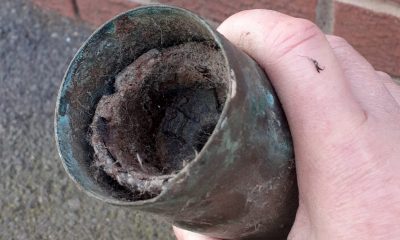By Mark Waghorn via SWNS
Organic carbon found on Mars may come from bugs that once roamed the Red Planet, according to new research.
The building blocks of life were in rocks collected by NASA's rover Curiosity.
They could have a "biological basis." The samples resemble fossilized remains of microbial life in Australia - that date back 2.7 billion years.
via GIPHY
Analysis of sediments from half a dozen locations - including an exposed cliff - identified an ancient carbon cycle.
The chemical element has two stable isotopes - 12 and 13. Looking at the amounts opens a window into its origin.
Lead author Professor Christopher House, of Penn State University said: "The samples extremely depleted in carbon 13 are a little like samples from Australia taken from sediment that was 2.7 billion years old.
"Those samples were caused by biological activity when methane was consumed by ancient microbial mats.
"But we can't necessarily say that on Mars because it's a planet that may have formed out of different materials and processes than Earth."
On Earth it would indicate past microbes consumed microbially produced methane.
Ancient Mars may have had large plumes of methane being released from the subsurface where production would have been energetically favourable.
Then, the released methane would either be consumed by microbes or react with ultraviolet light and be deposited directly on the surface.
Methane - the simplest organic molecule - is known to be present in Mars' atmosphere.
Curiosity has been roaming Gale Crater for over nine years - drilling under the surface and sending the results back home.
It's believed to have been a deep lake 3.5 billion years ago containing complex organic molecules - key raw materials for life as we know it.
Prof House said: "The amounts of carbon 12 and carbon 13 in our solar system are the amounts that existed at the formation of the solar system.
"Both exist in everything, but because carbon 12 reacts more quickly than carbon 13, looking at the relative amounts of each in samples can reveal the carbon cycle."
Curiosity heated the samples in the absence of oxygen to separate any chemicals.
Scans showed some were exceptionally depleted in carbon 13 while others were enriched.
Other plausible theories include a cosmic dust cloud - or ultraviolet radiation breaking down carbon dioxide.
Prof House said: "All three of these scenarios are unconventional - unlike processes common on Earth."
Curiosity has been roaming Gale Crater for over nine years - drilling under the surface and sending the results back home.
Prof House said: "The amounts of carbon 12 and carbon 13 in our solar system are the amounts that existed at the formation of the solar system.
"Both exist in everything, but because carbon 12 reacts more quickly than carbon 13, looking at the relative amounts of each in samples can reveal the carbon cycle."
Prof House said finding the remains of microbial mats could clear things up.
NASA's rover Perseverance which landed last February is currently drilling
Jezero crater - the site of an ancient lake - for signs of past life.
Prof House said: "We are being cautious with our interpretation - which is the best course when studying another world."
Curiosity is still collecting and analysing samples. It will be returning to the site where it found some of the samples in about a month.
Prof House said: "This research accomplished a long-standing goal for Mars exploration.
"To measure different carbon isotopes - one of the most important geology tools - from sediment on another habitable world. It does so by looking at nine years of exploration."
Also working on the project from Penn State was Gregory M. Wong, recent doctoral recipient in geosciences.
The study was published in Proceedings of the National Academy of Sciences.

 Parenting1 day ago
Parenting1 day ago
 Broadcast3 days ago
Broadcast3 days ago
 Broadcast2 days ago
Broadcast2 days ago
 Broadcast1 week ago
Broadcast1 week ago
 Funny1 week ago
Funny1 week ago
 Shopping1 week ago
Shopping1 week ago
 Money3 days ago
Money3 days ago
 Parenting1 week ago
Parenting1 week ago






















